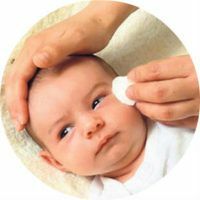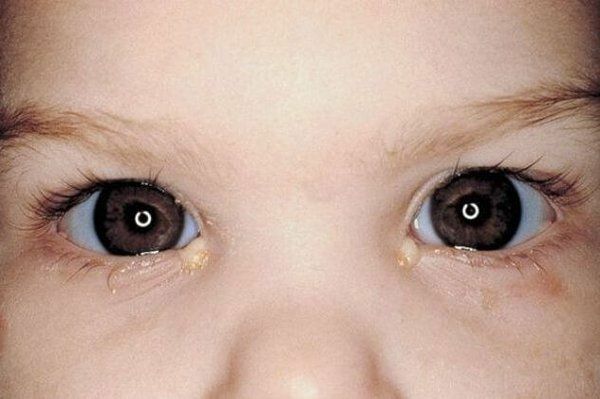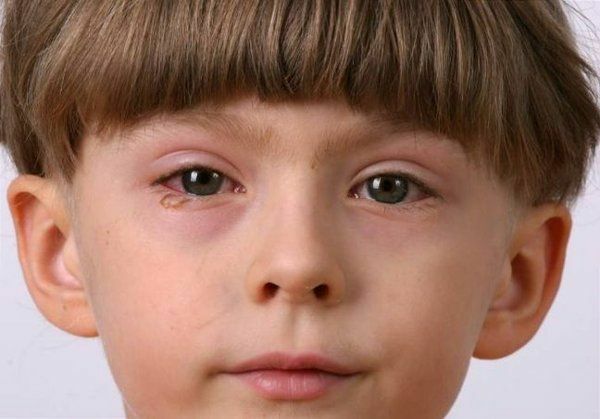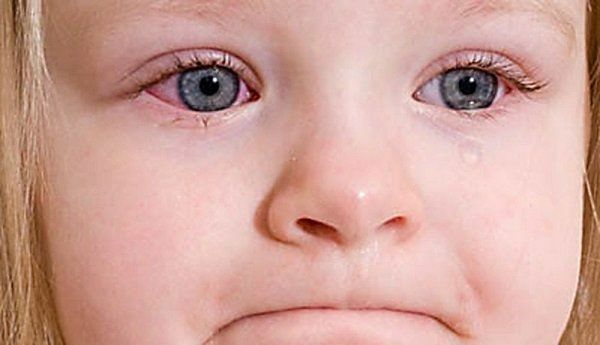
Conjunctivitis is one of the most common diseases, its main symptom is inflammation of the conjunctiva( eye mucosa).Despite the fact that the disease is not considered dangerous, preventive measures should be taken, especially when it comes to children.
- Symptoms
- Types and causes
- Infectious
- Noninfectious
- Forms
- How dangerous
- Diagnostics
- Treatment
- Preparations
- Traditional methods
- herbal and medicinal teas
- Infusions
- lotions and compresses
- Prevention
Symptoms
diagnose conjunctivitis in adults and children do notis labor, all symptoms are noticeable to the naked eye. Children bear the disease heavier, they become more restless, they can begin to cry and be capricious. The disease is often characterized by rapid development, the baby wakes up in the morning with stitched eyes. With conjunctivitis of bacterial origin, both eyes are often affected. Pathology is accompanied by sensations of irritation, sand in the eyes, purulent secretions, which form after a while crusts.
Symptoms of conjunctivitis:
- redness of the eyes and severe itching;
- swelling of the eyelids, and sometimes of the mucous membranes;
- formation of follicles on conjunctiva;
- discharge of watery fluid from the eyes;
- loss of vision clarity;
- sensation of a foreign object in the eye;
- tear;
- thread when looking at the light;
- inflammation of the lymph nodes at the neck and behind the ears;
- gluing eyelashes after sleep, especially night, longer;
- in some cases - an increase in body temperature.
Older children may complain of decreased vision, rapid eye fatigue, and lack of appetite.
In case of viral origin of the disease, the disease is accompanied by certain manifestations in the upper respiratory tract, it can be both rhinitis and a sore throat.
to contents ^Species and causes
Conjunctivitis is classified according to the causative agent of the disease:
to the contents ^Infectious
Infection of the eye mucosa and development of the disease is facilitated by contact with the patient, poor sanitary conditions, reduced immunity.
- Bacterial. Occurs under the influence of staphylococci, streptococci, gonococci, pneumococci. The name of the disease is characterized by the type of pathogenic microorganism - blenocoenal conjunctivitis, diphtheria, pneumococcal. Often accompanied by purulent manifestations.

- Fungal. The development of the disease provokes pathogenic or opportunistic fungi, which can get into the eyes from other foci of infection on the body.
- Chlamydia. The causative agent of the disease are chlamydia.
- Viral .Often develops in parallel with a viral infection, the standard signs are added pain in the throat, runny nose, subfebrile condition( persistent rise in temperature to 37-37.5 degrees).The causative agent of the disease may be adenovirus, herpes, measles, chicken pox.

Non-infectious
Develops due to damaging effects of chemical or physical factors, allergens.
- Reactive .Causes of the disease may be poor-quality cosmetics, air pollution by chemical suspensions, bathing in pools with purified water, exposure to bright light or radiation, mechanical damage to the conjunctiva due to the ingress of foreign microparticles onto its surface.
- Allergic. Develops in people with increased sensitivity to a number of substances: house dust, household chemicals, animal hair, food, pollen, some medicines.

Forms
Depending on the course of inflammation, conjunctivitis occurs:
- Acute .It begins suddenly and is characterized by the rapid development of the disease.
- Chronic .It occurs as a result of an incomplete acute form of conjunctivitis, prolonged exposure to allergens, traumas of lacrimal ducts or nose. It is characterized by a slow and long development.
Than
- is dangerous If the treatment is incorrect or insufficient, the acute form of conjunctivitis can be transformed into a chronic one, with frequent exacerbations. Children with inflammation of the mucosa feel a strong discomfort, become capricious.
- Chronic form and allergic conjunctivitis do not carry a threat to others, the most dangerous are the viral and bacterial forms that are transmitted by close contact. Risk factor is the visit of children's institutions with a large number of children, the disease is transmitted through toys and public objects. Sometimes in children's groups there is an epidemic.
- With viral conjunctivitis, the incubation period lasts for 4-12 days, and the treatment can last 7-20 days.
- Bacterial conjunctivitis can cause damage to the cornea. In severe cases, the development of inflammation of the cornea( keratitis), which threatens deterioration or loss of vision, so the first symptoms of the disease should immediately consult a doctor.
Diagnosis
For the first symptoms of conjunctivitis, consult a physician. The ophthalmologist performs the following actions:
- eye examination;
- interview with a patient - in order to find out the cause and conditions for the development of the disease;
- bacteriological study of washings with conjunctiva - is performed to clarify the type of pathogen;
- skin tests for the detection of an allergen - are performed with allergic conjunctivitis.
Treatment of
to the table of contents ^Drugs of
Various groups of drugs can be used for the disease:
- Antibiotics - Vitabakt, Kolbiocin, Levomycetin, Tetracycline, Fucitalmic, Erythromycin. Applied with bacterial conjunctivitis. The drugs are presented in the form of eye drops and ointments, which are buried or placed behind the eyelid. In newborns, drops based on albucid are used to prevent and treat gonorrheal conjunctivitis.
- Anti-inflammatory - eye drops based on diclofenac sodium or glucocorticosteroids( hydrocortisone or prednisolone).They are used for non-infectious diseases.
- Antiallergic - Allergodil, Vizin, Zaditen, Kromogeksal. Such eye drops are used for allergic conjunctivitis. They can be combined with the use of antihistamines of systemic action( tablets, solutions for internal use).
- Drops for moisturizing the conjunctiva - Defislez, Inox, Ophtholite, Systein. The so-called "artificial tears" have a good therapeutic effect with conjunctivitis, caused by the impact of negative physical factors.
Treatment of conjunctivitis should be under the supervision of a doctor who will prescribe medications taking into account the characteristics of the disease and the age of the patient.
to table of contents ^Folk methods
For eyewash apply:
to the table of contents ^Herbal and medicinal broths
- weak welding of black tea;
- chamomile broth;
- solution of table salt in a dosage of 1 teaspoon per glass.
Infusions
- Chamomile - 1-2 tablespoons of dried, crushed flowers pour 200 ml of boiling water and insist in a sealed container for about an hour;
- violet - 1 tablespoon dried flowers, ground to a powdery state, pour a glass of boiling water and insist under the lid for about half an hour.
- leaves of aloe - 1 teaspoon of finely chopped leaves pour 100 milliliters of boiling water, insist half an hour and strain through gauze, apply warm.
Lotions and compresses
Drug or home remedy is applied to a cotton-gauze tampon and applied to the eyes for 15 minutes. Of the tinctures of their own preparation, the most commonly used are:
- root of the althea medicinal - 2-3 teaspoons pour 200 milliliters of cold, necessarily boiled, water and infuse 8 hours;
- dill - 1 tablespoon per 300 milliliters of boiling water, insist under the lid for about half an hour;
- raspberry leaves - 2 tablespoons per cup of boiling water, insist under the lid for about 40 minutes, strain through gauze before use;
- herbal collection of peppermint leaves, plantain leaves, European clapfoot leaves, bilberry leaves, rhizomes of elecampane high, dill fruits - 1 tablespoon of this dried mixture pour a glass of steep boiling water in a thermos and insist for several hours, before using to filter.
In some cases, conjunctivitis passes by itself, for its treatment it is sufficient to use disinfectant solutions at home. But sometimes such therapy is not enough, and the disease can go into a chronic form. Therefore, it is very important to have an examination with an ophthalmologist.
to contents ^Prevention
To prevent conjunctivitis in children, parents should follow the following recommendations:
- teach the child to comply with sanitary standards, use a separate face towel;
- wean to rub eyes, especially when in contact with other children and during walks;
- it is recommended to periodically ventilate the room and do a wet cleaning once a day;
- Avoid exposure to eye irritants( bright light, exposure to hard irritants and chemicals);
- all products should be thoroughly washed;
- should avoid contact with infected children;
- in order to strengthen immunity recommended walking in the fresh air lasting from 2 hours per day;
- , a pregnant woman should be screened, including for urogenital infections, since infection of newborns can occur during childbirth.
